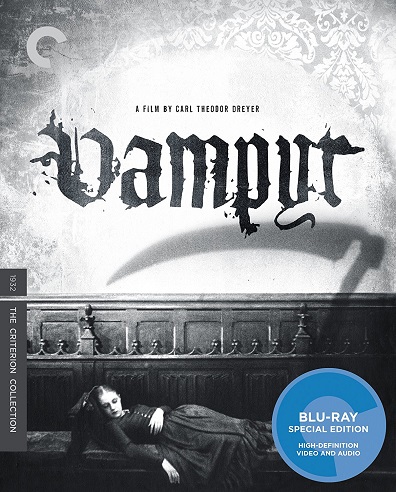
Vampyr
Studio: Criterion
Oct 03, 2017
Web Exclusive
![]()
Released in 1932, Vampyr is Danish filmmaker Carl Theodor Dreyer’s follow-up to his 1928 masterpiece, The Passion of Joan of Arc. Shot independently by Dreyer utilizing real locations and non-professional actors, the film was made at a time when the young medium of cinema was experiencing drastic upheaval. Originally conceived by Dreyer as a silent film, Vampyr was eventually produced to include the then cutting edge innovation of sound and was shot to accommodate French, German and English dubbing. It was then edited extensively by Dreyer to satisfy the concerns of distributors and audiences. The resulting film is a dreamy, enigmatic work of art, something like Dracula seen through the eyes of David Lynch.
Dreyer based Vampyr on “Carmilla,” a 1872 short story by Sheridan Le Fanu, but the film’s set-up recalls Bram Stoker’s classic novel as well as its then recent adaptations, Nosferatu and Dracula. Allan Gray is a young man obsessed with the occult who travels to the small town of Courtempierre and finds it under the curse of a mysterious vampire. Unlike Dracula and its various other cinematic permutations, Vampyr jettisons much in the way of plot and character in order to explore the dream-like horror incurred by its titular monster. Although he conceded to shoot with sound, Dreyer has little use for it beyond some eerie music and sound effects, coupled with some basic exposition. His visual style feels shockingly modern and nothing like the stagy efforts of many other silents of the era. The camera glides through the gorgeous, fog-drenched locations, often revealing characters or objects in a way that recalls stumbling upon something in a dream. That’s certainly the case for star Nicolas de Gunzburg - acting under the name Julien West - a wealthy socialite who agreed to finance the film in exchange for the starring role. Despite de Gunzburg’s lack of skill, Dreyer uses his handsome features and blank expression to wonderful effect, implying that entire scenes of the film are waking nightmares through which Gray is aimlessly wandering. This strange atmosphere is further maintained via various camera tricks and special effects such as shadows moving backwards or independently of their casters, as well as double exposures that allow character’s spirits to step out of their sleeping bodies.
The new Blu-ray transfer of the film by Criterion gives gorgeous new life to the film’s dilapidated found locations and the alternatively beautiful and hideous faces of its cast. Such detailed restorations of films as old as Vampyr go a long way toward making the history of cinema feel vital and relatable to modern viewers, creating the sense that one could step into the frame or that the characters could just as easily step out. The weighty package includes a thick booklet featuring the original screenplay as well as a reprinting of the short story, “Carmilla.” The disc supplements include a documentary on Dreyer’s career, a commentary track by film scholar Tony Rayns and a lengthy visual essay exploring the production and themes of Vampyr by scholar Casper Tybjerg.
www.criterion.com/films/661-vampyr
Current Issue

Issue #72
Apr 19, 2024 Issue #72 - The ‘90s Issue with The Cardigans and Thurston Moore
Most Recent
- Strand of Oaks Shares Video for New Song “Future Temple” (News) —
- Monsters of Folk Announce 15th Anniversary Reissue, Share Previously Unreleased Song “Disappeared” (News) —
- John Grant Shares Lyric Video for New Song “All That School For Nothing” (News) —
- Cassandra Jenkins Shares Self-Directed Video for New Song “Delphinium Blue” and Announces Tour Dates (News) —
- Hyperdrama (Review) —

Comments
Submit your comment
There are no comments for this entry yet.